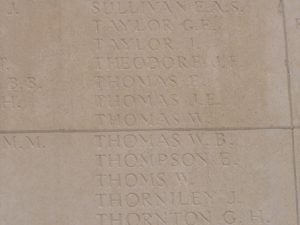Abernant is a small village situated four miles north-west of Carmarthen. I have no photographs of any war memorials in the village, but the 1922 published Carmarthen County War Memorial Roll named two men from the village who had fallen during the Great War, T. Griffiths and J. H. Phillips. I have also discovered another man from the village who had emigrated to Canada, and fell while serving with the Canadians. I have a photograph of the memorial inside the Church for J. H. Phillips, but is there anything else located there? Any photographs of local memorials would be most welcome. As a result, this page commemorates the men known to have been either born in or resided in Abernant at some time prior to the war.
The Great War, 1914-1918
Thomas Davies, Private, 234845, Canadian Infantry. Thomas was born on 25 November 1884, the son of Samuel Davies and Rachel Davies (nee Bowen), of Blaenbran, Abernant. He emigrated to Canada prior to the war, and found work as a seedsman, settling at 308, Princess Avenue, Brandon, Manitoba. Thomas enlisted at Brandon into the 203rd Battalion, Canadian Infantry on 26 April 1916. After several months of training he embarked for England with the battalion aboard the SS Grampian, disembarking on 4 November 1916 and entraining for the Canadian Camp at Seaford, where he was transferred to the 18th Reserve Battalion. On 5 March 1917 Thomas was drafted to France and was posted to the 52nd Battalion (North Ontario), Canadian Infantry, which was attached to the 9th Canadian Brigade, 3rd Canadian Division. Thomas saw his first major action during the Battle of Vimy Ridge, which opened on 9 April 1917. The Canadians stormed the heights of the ridge, capturing the high ground over the entire battlefield. Further fighting followed, when the Canadians attacked La Coulotte on 23 April, then took part in the Third Battle of the Scarpe on 3/4 May. Thomas was wounded on 18 July 1917 and spent over a week in hospital before rejoining his battalion at Gouy-Servins on 27 July. Thomas was killed later that summer, during the capture of Cinabar Trench, near Arras, on 3 September 1917. The 32-year-old has no known grave and is commemorated on the Vimy Memorial, France.

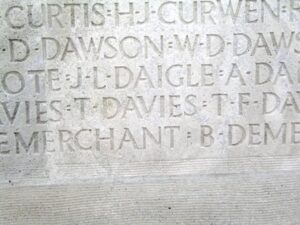
Thomas Griffiths, Private, 12071, South Wales Borderers. Thomas was born in 1898, the son of Anna Griffiths, of Penrheol, Abernant. He enlisted at Llanelli into the army and was posted to France in the summer of 1916, joining the 2nd Battalion, South Wales Borderers. The battalion had fought in China at the outbreak of war, before returning to Britain to join 87 Brigade, 29th Division. It took part in the Gallipoli landings on 25 April 1915, and remained there until evacuation in January 1916. The Division took part in its first major action in France during the 1916 Somme Offensive, and fought at the Battles of Albert and Le Transloy, suffering heavy casualties. John most probably joined the battalion after this terrible period. In the Spring of 1917 the Division fought at the Battle of the Scarpe, which was part of the Arras Offensive, seeing heavy fighting around Monchy-le-Preux, and then moved further north to Ypres, initially to hold the line whilst other units had been withdrawn for specialist training, in readiness for the Third Battle of Ypres, which opened on 31 July 1917. The 29th Division went into reserve whilst the first attacks, the Battle of Pilckem Ridge, took place, then on the night of 14-15 August the 2nd SWB moved into the line facing Langemarck, ready to launch another offensive. On the following day the battalion reconnoitred the ground in front of them, and laid white tapes in No Man’s Land, to guide the attacking troops, and at dawn on 16 August 1917 the 2nd SWB launched an attack on Langemarck. The battalion successfully took its two objectives, but had suffered 163 casualties. The Division then had another period out of the line to rest and refit before taking part in further fighting near Poelcapelle. Early in November 1917 the Division was relieved from the line at Ypres, and moved south to the Bellacourt area, to prepare to take part in the forthcoming Battle of Cambrai. The Division entrained for Péronne on 17 November, marching to a camp four miles out of the town at Haut Allaines, then by midnight on 18 November had reached Fins. On the following day the Division received its battle stores and detailed orders for the forthcoming battle, marching off via Gouzeaucourt to its assembly positions at Marcoing. The assault began at dawn on 20 November, but the Division suffered terrible casualties whilst attacking Masnières, on the Hindenburg Line. Thomas was killed on 21 November 1917, during the assault on Masnières. The 20-year-old was buried in Marcoing British Cemetery, France.
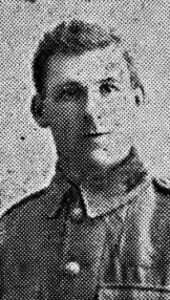
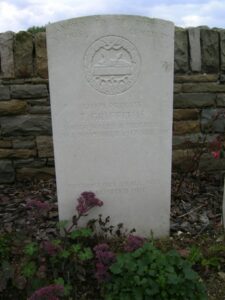
James Howell Phillips, Private, 320314, Welsh Regiment. James was born in 1894, the son of John Phillips and Anne Phillips (nee Howell), of Ysgerfa, Talog Road, Abernant. He enlisted at Carmarthen in September 1914 into the Pembroke Yeomanry. During March 1916 the 1/1st Pembroke Yeomanry moved to Egypt, where it merged with the Welsh Border Mounted Brigade and formed the 4th Dismounted Brigade. On 2 February 1917 it merged with the 1/1st Glamorgan Yeomanry to form the 24th Battalion, Welsh Regiment, and became attached to 231 Brigade, 74th (Yeomanry) Division. The Division assembled in Egypt as part of the EEF, before crossing the Suez Canal into the Sinai, and saw its first major action during the Second Battle of Gaza. The battle was a failure, and the EEF was re-organised under a new commander, Sir Edmund Allenby, before launching the Third Battle of Gaza on the night of 31 October 1917. This assault was launched along a winder front, running from Gaza to Beersheba, and this time the EEF prevailed, opening the door to Jerusalem. James was killed during an attack by the 24th Welsh on the Sheria heights on 6 November 1917. The 23-year-old is buried in Beersheba War Cemetery, Israel.
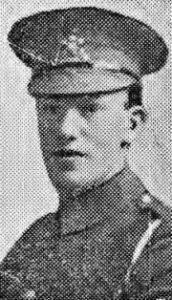
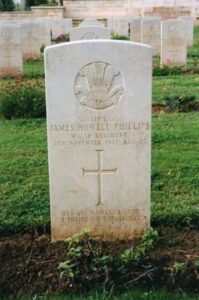
John Edward Thomas, Corporal, 40215, Royal Welsh Fusiliers. John was born in Abernant in 1889, the son of Samuel Thomas and Sarah Thomas. The family moved to Carmarthen around the turn of the century, settling at 64, Priory Street, Carmarthen. John was the manager of the Wymans Book Stall at Carmarthen Station for three years, prior to enlisting at Carmarthen into the army, and was posted to France in the summer of 1917, joining the 17th Battalion, Royal Welsh Fusiliers. The battalion was attached to 115 Brigade, 38th (Welsh) Division. John joined the battalion at Boesinghe, where it was preparing to take part in the opening assault of the Third Battle of Ypres, or Passchendaele. On 31 July 1917 the Division launched its famous assault on the Pilckem Ridge, capturing Iron Cross and reaching its objective of the Steenbeek, then played a supporting role in the Battle of Langemarck. The Division was transferred to the Sailly-sur-la-Lys sector in September, and remained in the area over the winter before being moved to positions north of Albert, at Bouzincourt Ridge, at the end of March 1918, relieving the battered 2nd and 47th Divisions. It held this sector, again carrying out minor operations and trench raids, over the coming months, before taking part in the great offensive of 21 August 1918, and began its advance towards the Hindenburg Line. Over the coming days captured Thiepval Ridge, Pozieres, Mametz Wood and High Wood, whilst advancing across the old Somme battlefields of 1916. The Division captured High Wood on 26 August, and then made towards Longueval. John was killed in action whilst advancing near Delville Wood on 30 August 1918. The 29-year-old has no known grave and is commemorated on the Vis-En-Artois Memorial, France.

